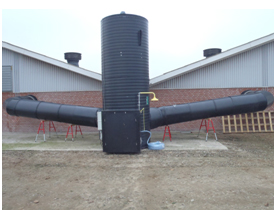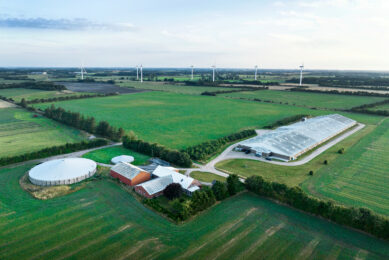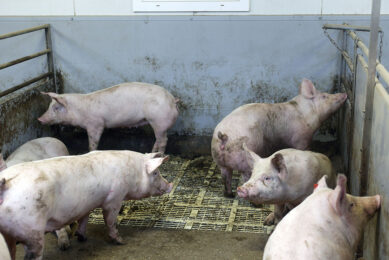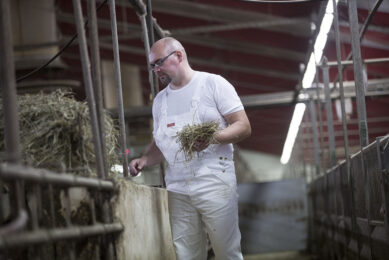Munters offers a solution to clogging of air cleaners

Munters has found the solution to problems with clogging of filter material in air cleaners. The solution is an air cleaner using nozzles instead of a filter. Another gold card for the livestock industry is partial air cleaning…
Design
The air cleaner is incorporated in a tube. At the bottom of the tube is a liquid reservoir holding a sulfuric acid solution with a pH level of 2. The liquid is pumped to nozzles which create a mist inside the tube. When the air from the livestock unit is sucked through the air cleaner it passes the mist. The sulfuric acid in the mist reacts with the ammonia in the air from the housing unit. The captured ammonia gets stored in the circulated liquid and drained to a manure tank. At the top of the air cleaner is the fan and beneath that there are two mist eliminators.
The air cleaner is incorporated in a tube. At the bottom of the tube is a liquid reservoir holding a sulfuric acid solution with a pH level of 2. The liquid is pumped to nozzles which create a mist inside the tube. When the air from the livestock unit is sucked through the air cleaner it passes the mist. The sulfuric acid in the mist reacts with the ammonia in the air from the housing unit. The captured ammonia gets stored in the circulated liquid and drained to a manure tank. At the top of the air cleaner is the fan and beneath that there are two mist eliminators.
Munters have their own factory which produces a huge range of mist eliminators to the industry in general. Between the two mist eliminators a group of nozzles are located and one time daily they automatically clean the mist eliminators.
Munters is the only company producing air cleaners which are able to reduce the ammonia concentration from livestock buildings with more than 90% and without using filter material. Normally air cleaners using sulfuric acid to reduce the ammonia emission from pig facilities consist of a filter block where the solution of sulfuric acid trickles through. However, the filter block can easily get blocked with dust and it is difficult to clean. The company introduces an air cleaner without a filter block.
Ammonia reduction
The capacity of the air cleaner is 25 000 m3/hour and the reduction of the ammonia concentration in the air through the air cleaner is more than 90%. Many farmers and people with ventilation knowledge will perhaps comment that an air cleaner with a capacity of 25 000 m3/hour is not big enough – even if a few number of air cleaners are installed on a farm. However, the Pig Research Centre in Denmark has shown that “partial air cleaning” instead of cleaning all the air from the housing unit can give a good ammonia reduction for the entire building if the air cleaner is efficient.
The capacity of the air cleaner is 25 000 m3/hour and the reduction of the ammonia concentration in the air through the air cleaner is more than 90%. Many farmers and people with ventilation knowledge will perhaps comment that an air cleaner with a capacity of 25 000 m3/hour is not big enough – even if a few number of air cleaners are installed on a farm. However, the Pig Research Centre in Denmark has shown that “partial air cleaning” instead of cleaning all the air from the housing unit can give a good ammonia reduction for the entire building if the air cleaner is efficient.
Partial air cleaning
In many climate zones in the world there is a huge variation of the outdoor temperature during the year. Mostly the livestock housing units are cooled by outdoor air, which results in a much lower ventilation rate in the housing unit during the winter period compared to the summer period. In contrast to the yearly differences in ventilation rate, the variation of the ammonia evaporation in the housing unit during the year is negligible.
In many climate zones in the world there is a huge variation of the outdoor temperature during the year. Mostly the livestock housing units are cooled by outdoor air, which results in a much lower ventilation rate in the housing unit during the winter period compared to the summer period. In contrast to the yearly differences in ventilation rate, the variation of the ammonia evaporation in the housing unit during the year is negligible.
In Denmark, the ventilation rate in a finishing unit is less than 20% of the maximum capacity 40% of the time in a year. That means, if an air cleaner is able to clean the first 20% of the maximum air capacity, then 100% of the air is cleaned 40% of the time during a year. In addition, the air cleaner will clean the first 20% of the air in the rest of the year. Totally it can be simulated and measured that if the farmer cleans 20% of the air, then he will be able to reduce the yearly ammonia emission by about 70%. This knowledge is a GOLD card for the livestock industry, because it is too expensive to clean all the air from a housing unit.
In a finishing unit in Denmark, the ventilation flow is less than 20% of maximum capacity 40% of the time during a year. If the first 20% of the ventilation flow is led through an air cleaner with an ammonia efficiency of 95% then about 70% of the total ammonia emission from the housing unit during a year is captured.
Similar graphs can be made for other climate zones, and the livestock industry in countries with cold winters will be able to get a high ammonia reduction by using partial air cleaning which is more economically realistic compared to cleaning all the air from a housing unit.
Plug and play
Chemical air cleaners have some advantages compared to biological air cleaners. Firstly the chemical air cleaners are able to reduce the ammonia emission by more than 90% as soon as they are installed. It is “plug and play” from day one. Often it takes 4-6 weeks before a biological air cleaner is running optimally. Therefore a temporary stoppage of the chemical air cleaner will not have a huge effect on the ammonia emission, because it will reduce the ammonia emission as soon as it gets started again. The farmer can even plan to stop the chemical air cleaner in periods with limited ammonia emission. In the broiler industry the ammonia emission is limited the first 10 days.
Chemical air cleaners have some advantages compared to biological air cleaners. Firstly the chemical air cleaners are able to reduce the ammonia emission by more than 90% as soon as they are installed. It is “plug and play” from day one. Often it takes 4-6 weeks before a biological air cleaner is running optimally. Therefore a temporary stoppage of the chemical air cleaner will not have a huge effect on the ammonia emission, because it will reduce the ammonia emission as soon as it gets started again. The farmer can even plan to stop the chemical air cleaner in periods with limited ammonia emission. In the broiler industry the ammonia emission is limited the first 10 days.
Another advantage is that the efficiency of the chemical air cleaner does not depend on the temperature. In biological filters the bacteria can die if it gets too cold because of stoppages or because the filter dries out. Also use of disinfectants can be a problem for biological filters because the micro organisms can get killed.
VERA test
Munters has started to sell the air cleaner in Denmark after it has been tested during from September 2010 – July 2011 of the Pig Research Centre, Denmark. The test showed that the ammonia concentration was reduced 93% on average. At the moment the air cleaner from Munters is tested on farm number 2 in order to get a VERA certificate (European test certificate). The test on the second farm will be finished in the beginning of 2013.
Munters has started to sell the air cleaner in Denmark after it has been tested during from September 2010 – July 2011 of the Pig Research Centre, Denmark. The test showed that the ammonia concentration was reduced 93% on average. At the moment the air cleaner from Munters is tested on farm number 2 in order to get a VERA certificate (European test certificate). The test on the second farm will be finished in the beginning of 2013.
(by Application manager, M.Sc. in Engineering, Ph.D, Merete Lyngbye)











